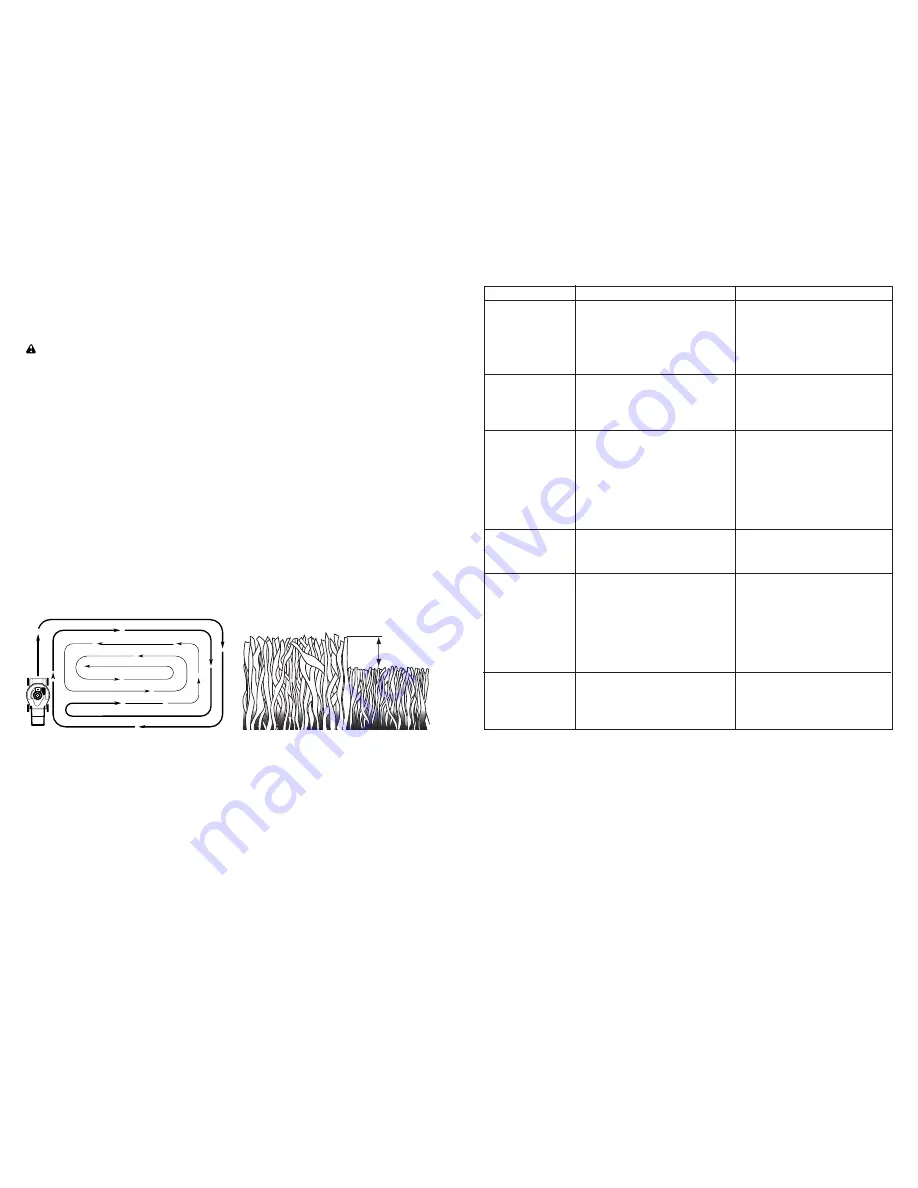
12
MULCHING MOWING TIPS
IMPORTANT
: For best performance,
keep mower housing free of built-up
grass and trash. See “CLEANING” in the
Maintenance section of this manual.
• The special mulching blade will recut
the grass clip pings many times and
reduce them in size so that as they fall
onto the lawn they will disperse into
the grass and not be noticed. Also,
the mulched grass will bio de grade
quick ly to provide nu tri ents for the lawn.
Always mulch with your highest engine
(blade) speed as this will provide the
best recutting action of the blades.
• Avoid cutting your lawn when it is wet.
Wet grass tends to form clumps and
in ter feres with the mulch ing action. The
best time to mow your lawn is the early
afternoon. At this time the grass has
dried, yet the newly cut area will not be
exposed to direct sunlight.
• For best results, adjust the lawn mower
cutting height so that the lawn mower
cuts off only the top one-third of the
grass blades. If the lawn is over grown
it will be nec es sary to raise the height
of cut to reduce pushing effort and to
keep from over load ing the engine and
leaving clumps of mulched grass. For
ex tremely heavy grass, reduce your
width of cut by overlapping previously
cut path and mow slowly.
• Certain types of grass and grass
con di tions may re quire that an area be
mulched a second time to com pletely
hide the clip pings. When doing a sec-
ond cut, mow across (perpendicular) to
the first cut path.
• Change your cutting pattern from week
to week. Mow north to south one week
then change to east to west the next
week. This will help prevent matting
and graining of the lawn.
MAX 1/3
• To start engine using the rope start er,
hold operator presence control bar
down to the han dle and pull starter
handle quickly. Do not allow starter
rope to snap back.
MOWING TIPS
CAUTION:
Do not use de-thatcher
blade attachments on your mower. Such
attachments are hazardous, will damage
your mower and could void your warranty.
• Under certain conditions, such as very
tall grass, it may be necessary to raise
the height of cut to reduce pushing
effort and to keep from over load ing the
en gine and leaving clumps of grass
clippings. It may also be necessary to
reduce ground speed and/or run the
lawn mower over the area a second
time.
• For extremely heavy cutting, reduce the
width of cut by overlapping pre vi ous ly
cut path and mow slowly.
• For side discharge operation, cut in
a coun ter clock wise di rec tion, start ing
at the outside of the area to be cut, in
order to spread grass clip pings more
evenly and to put less load on the
engine. To keep clip pings off of walk-
ways, flower beds, etc., make the first
cuts in a clock wise direction.
• If a trail of grass clipping is left on the
right side of the lawn mower during rear
discharge operation, mow in a clock-
wise direction with a small overlap to
collect the clippings on the next pass.
• Pores in cloth grass catchers can be-
come filled with dirt and dust with use
and catchers will collect less grass. To
prevent this, regularly hose catcher off
with water and let dry before using.
• Keep top of engine around starter clear
and clean of grass clippings and chaff.
This will help engine air flow and extend
engine life.
21
PROBLEM CAUSE
CORRECTION
TROUBLESHOOTING - See appropriate section in manual unless directed
to a Sears Parts & Repair Centre.
Poor cut –
1. Worn, bent or loose blade.
1. Replace blade. Tighten
uneven
blade
bolt.
2. Wheel heights uneven.
2. Set all wheels at same
height.
3. Buildup of grass, leaves
3. Clean underside of
and trash under mower.
mower housing.
Excessive
1. Worn, bent or loose blade.
1. Replace blade. Tighten
vibration
blade
bolt.
2. Bent engine crankshaft.
2. Contact a Sears or other
qualified
service
centre.
Starter rope
1. Engine flywheel brake is on 1. Depress control bar to
hard to pull
when control bar is released. upper handle before
pulling starter rope.
2. Bent engine crankshaft.
2. Contact a Sears or other
qualified
service
centre.
3. Blade adapter broken.
3. Replace blade adapter.
4. Blade dragging in grass.
4. Move lawn mower to cut
grass or to hard surface.
Grass catcher
1. Cutting height too low.
1. Raise cutting height.
not filling
2. Lift on blade worn off.
2. Replace blade.
(If so equipped)
3. Catcher not venting air.
3. Clean grass catcher.
Hard to push
1. Grass is too high or wheel
1. Raise cutting height.
height is too low.
2. Rear of lawn mower
2. Raise rear of lawn mower
housing or cutting blade
housing one (1) setting
dragging in grass.
higher.
3. Grass catcher too full.
3. Empty grass catcher.
4. Handle height position not 4. Adjust handle height to suit.
right for you.
Loss of drive
1. Belt wear.
1. Check/replace drive belt.
or slowing of
2. Belt off of pulley.
2. Check/reinstall drive belt.
drive speed
3. Drive cable worn or broken. 3. Replace drive cable.
4. “Loose” drive control system. 4. Adjust drive control.


































